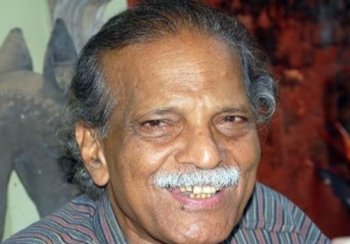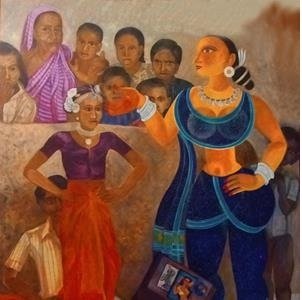
|   |

|   |
 e-mail: leelakaverivenkat@gmail.com Requiem for an artist and cultural activist August 31, 2016  In the sudden death of Dinanath Pathy on Monday 29th August 2016, Odisha has lost one of its committed cultural figures, and one who wore several hats connected with visual and performing arts. A contemporary painter, scholar and art historian who authored several books, he was also a publisher of quality art journals with special accent on dance, like Angarag. Dinanath worked in several capacities for many art institutions. He was Curator Art and Crafts at the Odisha State Museum, Principal of the B.K. College of Art and Crafts, Bhubaneswar, Secretary of the National Academy of Art, New Delhi, and lately he had been working as Director of the Alice Boner Institute at Varanasi. His fine mind with an art awareness stemming from painstaking research into art History and Art Ethnology connected with Odisha, encompassed subjects pertaining to all art forms. Born in the princely town of Ganjam's Digapahandi in the year 1942, he always thought of himself as a proud son of this district, which was part of ancient Kalinga, famous for its literature which still forms the textual backbone for a great deal of Odissi dance and music, and a region rich in art of many dimensions. Travelling extensively with his brother in whose workshop Charukala Mandir - Temple of Fine Arts, he was initiated into art of painting on theatre curtains, painting murals for weddings, Osakothi shrine painting, he also apprenticed in make-up for theatre and prop designing, early in life acquiring a real feel for performing arts - thanks to growing up amongst theatre artists of Sakhinata, Krishnalila, Radhapremlila, Prahaladanataka, Daskathia, Dandanata, Dhumpa, all from the Ganjam region. He evolved further as an art thinker, when years later he accompanied the Director of the Museum Reitberg Zurich, Switzerland, Dr. Eberhard Fischer and his wife Barbara, who were working on an exhibition project for Odisha. He always told me that this couple gave him a proper evaluation of the importance of Ganjam's art forms, which he had, till then more or less taken for granted. The collaboration with the Fischers led to a significant 360 page book profusely illustrated, ORISSA: Kunst und Kultur, which traced a very significant tribal, folk, classical continuum, and another book as a tribute to Sanjukta Panigrahi after her premature death. As a visual artist, Dinanath saw almost an extension of the Ganjami art in Bali of South East Asia and the logical corollary to this, reviving the memory of this connection was the International Kalinga Bali Jatra of Odisha, planned during the time of Chief Minister Harekrushna Mahatab and started in the nineties when Biju Patnaik was Chief Minister. Dinanath's style of bold paintings of Lakshmi Narasimha, Panchamukhi Ganesh, Hanuman, and his acrylic on canvas painted in 2013 of Coronation of Rama, along with his full breasted strongly outlined female figures like Mangala and Kali along with his paintings on Baghanat (human figures with body painted in tiger like stripes), Sakhipilla and even tribal figures - all carry the strong flavour of Ganjam's culture.  Painting by Dinanath Pathy Having been in the midst of Odissi as it was being redesigned, Dinanath had very definite views on the dance as it was propagated. Pathy shared a very close friendship with the likeminded late Debaprasad Das. Not known for his diplomacy, the fact of the Guru being no favourite of the cultural establishment in Odisha, did not make the slightest difference to Pathy's loyalties. In his book Rethinking Odissi, his very forthright statements on what he felt was not in the interests of the dance form, earned him some strong dissenters. Dinanath felt strongly about the rich performing arts of Ganjam (whose poets contributed all the poetry for music and dance) being kept out of the purview while the new Odissi format was being structured in the late fifties. With Jagannath as the central deity, it was Orissan art of Puri and the area round it that was considered as expressive of the cultural identity of the State. It was a political decision because Ganjam having been part of the old Madras Presidency, with its mixed Telugu/Odiya inheritance made the establishment very wary of the new 'classical' dance showing even a remote influence of the south. Thus Sakhinata was ignored while Gotipua was not. When dancer/choreographer Ramli Ibrahim of Sutra Foundation, Malaysia, produced Ganjam, a blockbuster Odissi group production, Dinanath was in the forefront of the art research group and as Production Consultant, his giant Osakothi mural pictures and his paintings providing a spectacular backdrop for the dance production. He was in the process of enthusiastically working for a visual artists' event, when death suddenly snatched him. Dinanath will be sorely missed.  Writing on the dance scene for the last forty years, Leela Venkataraman's incisive comments on performances of all dance forms, participation in dance discussions both in India and abroad, and as a regular contributor to Hindu Friday Review, journals like Sruti and Nartanam, makes her voice respected for its balanced critiquing. She is the author of several books like Indian Classical dance: Tradition in Transition, Classical Dance in India and Indian Classical dance: The Renaissance and Beyond. Post your comments Please provide your name and email id when you use the Anonymous profile in the blog to post a comment. All appropriate comments posted with name & email id in the blog will also be featured in the site. |